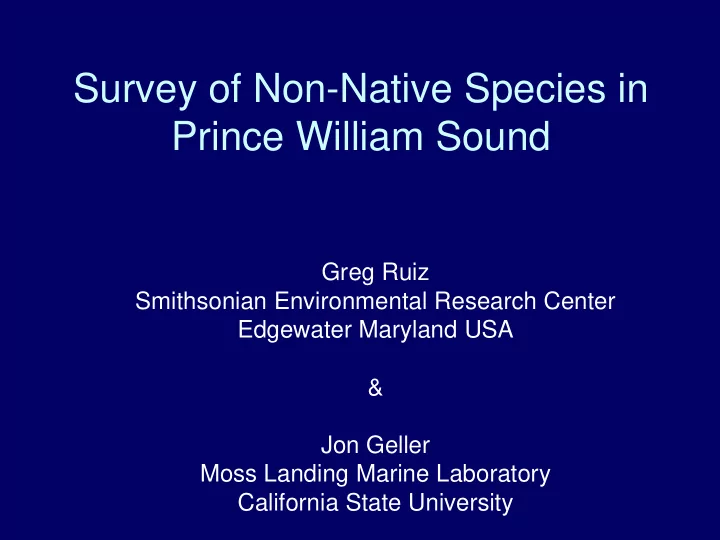

Survey of Non-Native Species in Prince William Sound Greg Ruiz Smithsonian Environmental Research Center Edgewater Maryland USA & Jon Geller Moss Landing Marine Laboratory California State University
Overview • Patterns of invasion for North America • Latitudinal pattern of invasions on Pacific coast • Testing for temporal changes in invasions: New invasions in Prince William Sound?
INVASIONS BY EUROPEAN GREEN CRABS 1980’s 1817 1989 2003 1980’s 1900
NEMESIS (National Exotic Marine and Estuarine Species Information System) Collections Reporting Literature Monitoring Records System Database Outputs & Applications Invasion Management Patterns Efficacy Early Detection / Predictions Rapid Response Management / Policy
Rate of new coastal invasions detected Increasing Discovery Rate for each coast of North America Coastal Invasions of the United States 100 West Coast Gulf Coast East Coast 80 Number of Invasions 60 40 20 0 0 30 60 90 120 150 180 Time (years) since 1790 (Ruiz et al. 2000) Ruiz et al 2000
~100,000 Arrivals to US Ports and Places Annually (Overseas + Domestic)
Latitudinal Pattern of Invasion Literature Review of known NIS Dutch Harbor Kodiak Island Kachemak Bay AK Prince William Sound Sitka Ketchikan Puget Sound Coos Bay Humboldt Bay San Francisco Bay Long Beach San Diego 0 30 60 90 120 150 180 Number of Species NEMESIS 2006
Explanations (hypotheses) • Biases in Data • Differences in Susceptibility to Invasions (Resistance: Biotic, Abiotic, Disturbance) • Differences in Propagule Supply (Propagule Pressure)
Standardized Surveys: Sessile Invertebrate Community
Standardized Surveys: Sessile Invertebrate Community
Conducting the Surveys: Methods Panels are constructed of 20 PVC panels and 2 PVC plastic and wood to wood blocks were attract species that settle deployed at 10 on hard surfaces and those different blocks per that bore into wooden embayment structures. Octob ober r 2004-KJL KJL
Standardized Surveys 30 BAYS X 10 BLOCKS X 20 PLATES (n=6,000) Plate Retrieval On-Site Analysis Voucher Collection/ Preservation Synoptic Collection / Archive Taxonomic Identification / Verification Data Analysis
Latitudinal Pattern of Invasion: Sessile Invertebrates Non-Native Species Richness 30 r 2 = 0.90 25 20 15 10 5 0 25 35 45 55 65 Latitude (Degrees N) Ruiz et al., unpublished data
Latitudinal Pattern of Invasion: Sessile Invertebrates Non-Native Species Richness 30 r 2 = 0.90 25 20 15 10 5 0 25 35 45 55 65 Latitude (Degrees N) Ruiz et al., unpublished data
Potential for Northward Spread ? de Rivera et al. 2011
Low Ship Traffic in Alaska Alaska Oregon and Washington California Panama 0 10,000 20,000 30,000 Number of Ship Arrivals (2004-2005)
Northward Spread of California Invasions AK First Record in CA First Recrod not in CA State / Province BC WA OR CA 0 50 100 150 200 250 300 Number of Species Ruiz et al. 2011
Study Goals • Test whether new invasions have occurred in PWS • Establish baseline to assess changes in marine communities over time
Approach • Identify species present in the sessile invertebrate community, using field surveys • Classify species as native, non-native, or cryptogenic • Use molecular genetic analyses to ground- truth consistency of identifications and test for cryptic species • Compare results to previous surveys and literature
Survey & Analyses • Six sites – selected to be in proximity to tanker traffic for PWS • 20 PVC settling plates per site • Deployed for 3 months in summer 2011 • Microscopic analyses: – Vouchers of each “ morpho- species” collected from 10 plates for morphological analyses – Vouchers of each “ morpho- species” collected from each site for genetic analyses
Atlantic barnacle: Amphibalanus improvisus Image courtesy of Prof. Christiane Maria Rocha Farrapeira, Universidade Federal Rural de Pernambuco- UFRPE, Brazil
Distribution (deRivera et al. 2007)
Results • Mis-match between taxonomic name based on morphological analyses and Genbank • Many species have no genotypes in Genbank to test for concordance • Greater genetic variation (structure) than expected for some morpho-species
Genetic Tree (COI) for Membranipora villosa in PWS
Next Steps • Molecular analysis of plankton samples • Consider repeated measures for sufficient baseline to track temporal changes and increase statistical confidence
Recommend
More recommend